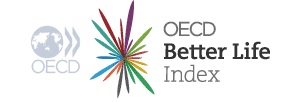Figuring out who has a better life
Posted by Elena del Valle on May 22, 2012

Graphic: Organization for Economic Co-operation and Development (OECD)
As we struggle in our day to day lives few of us stop to ponder the big picture. Are we happy? What does it take to have a good life? Is it education, money, a good balance of work and life, safety? Policy makers ask additional questions such as, do men and women want the same things when it comes to living well? Do people in different countries, even neighboring countries, share views about the common elements that lead to a high quality of life?
In 2004, the Organization for Economic Co-operation and Development (OECD) began to explore meaningful ways to establish quality of life. For the past two years the OECD has been looking a quality of life issues beyond just economics and gross domestic product (GDP) with the mission to “develop better indicators for better policies for better lives.”
Last year, for the first time, it released the results of its Better Life Index (BLI) in which researchers examined 11 indicators among 34 members of the organization including the United States and: Australia, Austria, Belgium, Canada, Chile, Czech Republic, Denmark, Estonia, Finland, France, Germany, Greece, Hungary, Iceland, Ireland, Israel, Italy, Japan, Korea, Luxembourg, Mexico, Netherlands, New Zealand, Norway, Poland, Portugal, Slovak Republic, Slovenia, Spain, Sweden, Switzerland, Turkey and United Kingdom.
To date one million visitors from 184 countries have visited the website to find out about the quality of life in the nations profiled. OECD staff looked at and shared their main findings about 11 Better Life Index dimensions: housing, income, jobs, community, education, environment, civic engagement, health, life satisfaction, safety, and work-life balance in 34 countries with the goals of developing good policies, allowing people to compare results, empower the public and make the information accessible. Those curious to know how their country compares with others among the 34 nations can see the latest results which become available today at http://oecdbetterlifeindex.org/
The top three drivers of well being were education health and life satisfaction and, according to their findings, there were only minor goal differences by gender. Across the board men work more and earn more. At the same time, women live longer, study more, are more social and in some countries are happier.
This year, Denmark had the highest life satisfaction and the highest work life balance, Switzerland was the country with the best health results, Finland showed the highest results in education, and Japan the highest results in security. The United States had the best ranking for income and housing.
Last year, 173,862 people visited the site from the United States; the cities with the highest participation were in descending order, New York, Washington, Chicago, San Francisco, Seattle, Los Angeles, Houston, Portland, Austin, and Boston.
The data used for the report came from the OECD or National Accounts, United Nations, and national statistics offices. Some were sourced from the Gallup World Poll, a division of the Gallup Organization that conducts public opinion polls in 140 countries around the world.
The mission of the Organisation for Economic Co-operation and Development (OECD) is to promote policies that will improve the economic and social well-being of people around the world.









